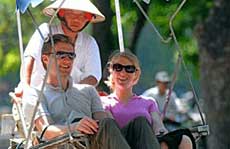Among the flow of people and vehicles in Hanoi’s old quarter, simple and beloved images of pedicabs with ringing bells leave a deep impression on many tourists.

A visit to Hanoi is not complete without touring the narrow ancient streets by pedicabs. The rather slow rolling of the wheels, passing steep-roofed houses and hearing both the strange and familiar sounds of life, gives tourists a taste of the local scene.
In that way, pedicabs go through each lane with their familiar bells and make the streets more ancient. Therefore, each tourist, when going by pedicab, always carries a camera to take photos of their most memorable moments in Hanoi. Pedicabs seem to raise up memories about Hanoi, together with The Huc Bridge and Tortoise Tower.
The name of the pedicab is borrowed from French. It is Vietnamized so much that many people would not guess that it first appeared here in colonial times. At first, it was a simple means of transport to carry goods. Then they began to be used to serve tourists.
In the 1990s, pedicabs became a tool to earn a living for many labourers. This was also the period when Hanoi had the largest number of pedicabs. Anywhere outside, you would see them under the trees along the road or at the market gate. You could hear the pedicab bell and see the smiles of pedicab riders everywhere. The rapid increase in available vehicles has made the pedicab almost obsolete for locals. However, it is still close to people’s lives in Hanoi’s old quarter and has become a unique feature in the tourism and wedding culture of the capital.
Now, just some 300 pedicabs are permitted to serve tourists in inner Hanoi. They are painted with the specific design of each company. Pedicab drivers also wear uniforms. Although they often come from other provinces, they know the lanes of each street in the old quarter. Their work is not simply to earn a living, but it is also a tourism and cultural activity. They often improve their knowledge and communication skills to become tour guides. They have become dear and close friends for foreign tourists who want to discover the beauty of the capital’s culture, architecture and gastronomy.